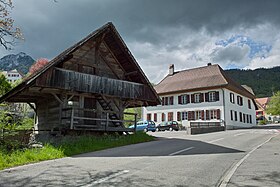Niederwil SO
| SO is the abbreviation for the canton of Solothurn in Switzerland and is used to avoid confusion with other entries of the name Niederwil . |
| Niederwil (SO) | ||
|---|---|---|
| State : |
|
|
| Canton : |
|
|
| District : | Livers | |
| Residential municipality : | Riedholz | |
| Postal code : | 4523 | |
| former BFS no. : | 2552 | |
| Coordinates : | 610051 / 233395 | |
| Height : | 545 m above sea level M. | |
| Area : | 2.28 km² | |
| Residents: | 395 (December 31, 2011) | |
| Population density : | 173 inhabitants per km² | |
|
In the center of Niederwil |
||
| map | ||
|
|
||
Niederwil (SO) (in the local dialect Nidrwiu ) is a village and until December 31, 2010 was a political municipality in the district of Lebern in the canton of Solothurn in Switzerland .
On January 1, 2011 Niederwil merged with the municipality of Riedholz .
geography
Niederwil lies at 545 m above sea level. M. , five and a half kilometers north-northeast of the canton capital Solothurn ( linear distance ). The village extends in the valley of the Siggern on the lower southern slope of the Jura at the foot of the Chamben, in the Unterleberberg region.
The area of the 2.3 km² area includes a section on the southern slope of the Jura. The central part of the area is formed by the valley basin of the Gummenbach , which extends in a west-east direction, between the Weissenstein range in the north and the Verena range, a small anticline off the Jura , in the south. The Siggern , which rises on the Balmberg and into which the Gummenbach flows below the village, flows into this valley basin. To the south of the Gummenbach, the community soil extends to the forest crest of the Winterhalden ( 604 m above sea level ; Verenakette), to the north of it it extends to the meadow slopes on both sides of the Siggern below Günsberg and Balm near Günsberg. Here is at 620 m above sea level. M. reached the highest point in Niederwil. In 1997, 8% of the municipal area was accounted for by settlements, 37% by forests and woodlands and 55% by agriculture.
Niederwil includes the Talacker residential area ( 540 m above sea level ) on the slope below Günsberg and a few individual farms. Due to the lively residential construction activity, the Niederwil settlement area has almost completely merged with that of Günsberg.
population
With 395 inhabitants (as of December 31, 2011) Niederwil was one of the small communities in the canton of Solothurn. 94.4% of the residents speak German, 2.0% speak Albanian and 0.9% speak Italian (as of 2000). The population of Niederwil was 213 in 1850 and 232 in 1900. In the course of the 20th century, the population increased to 309 people by 1920, and then decreased again to 245 inhabitants by 1960. Since then a significant increase in population has been recorded.
economy
Until the second half of the 20th century, Niederwil was a village dominated by agriculture . In the 17th and 18th centuries there was a gypsum mill in Niederwil, in which the gypsum extracted above Günsberg was processed. A rapeseed oil mill used to be operated by the water power of the Gummenbach.
Even today, agriculture and fruit growing as well as cattle breeding have a certain place in the income structure of the population. Further jobs are available in local small businesses and in the service sector. Today, smaller companies from the construction, transport and electrical industries are represented in the community. In the last few decades the village has developed into a residential community thanks to its attractive location. Many employed people are therefore commuters who mainly work in the Solothurn region.
traffic
The former community is located off the main thoroughfares on a connecting road from Attiswil to Balm near Günsberg . The nearest connection to the A1 motorway (Bern-Zurich) is around 7 km from the town center. Niederwil is connected to the public transport network through a Postbus course , which covers the route from Solothurn to Balm near Günsberg.
history
The first written mention of the place took place on June 13, 1307 under the name Niderwile . The place name bears the meaning of the lower hamlet , based on Balm near Günsberg or Günsberg.
Since the Middle Ages Niederwil has been under the rule of Balm . Together with this rule, the village came to the Counts of Strassberg as an imperial fief in 1312 and, after various changes of ownership, to Solothurn in 1411. The city had already had high jurisdiction over Niederwil since 1344. In the 15th century, the village was under the Bailiwick of Balm, from 1487 it was part of the Bailiwick of Flumenthal . After the collapse of the Ancien Régime (1798), Niederwil belonged to the Solothurn administrative district during the Helvetic Republic and to the Lebern district from 1803. Niederwil does not have its own church, it belongs to the parish Flumenthal-Günsberg.
Attractions
coat of arms
- In blue, a white plaster stamp consisting of a corrugated tree , covered with three stumps (in motion) on seven white limestones
The coat of arms alludes to the former gypsum mining in Günsberg and the processing in the Niederwil Gipsribi gypsum mill .
Web links
- Official website of the municipality of Riedholz (with Niederwil)
- Urs Zurschmiede: Niederwil (SO). In: Historical Lexicon of Switzerland .
Individual evidence
- ^ State Archives of the Canton of Lucerne




